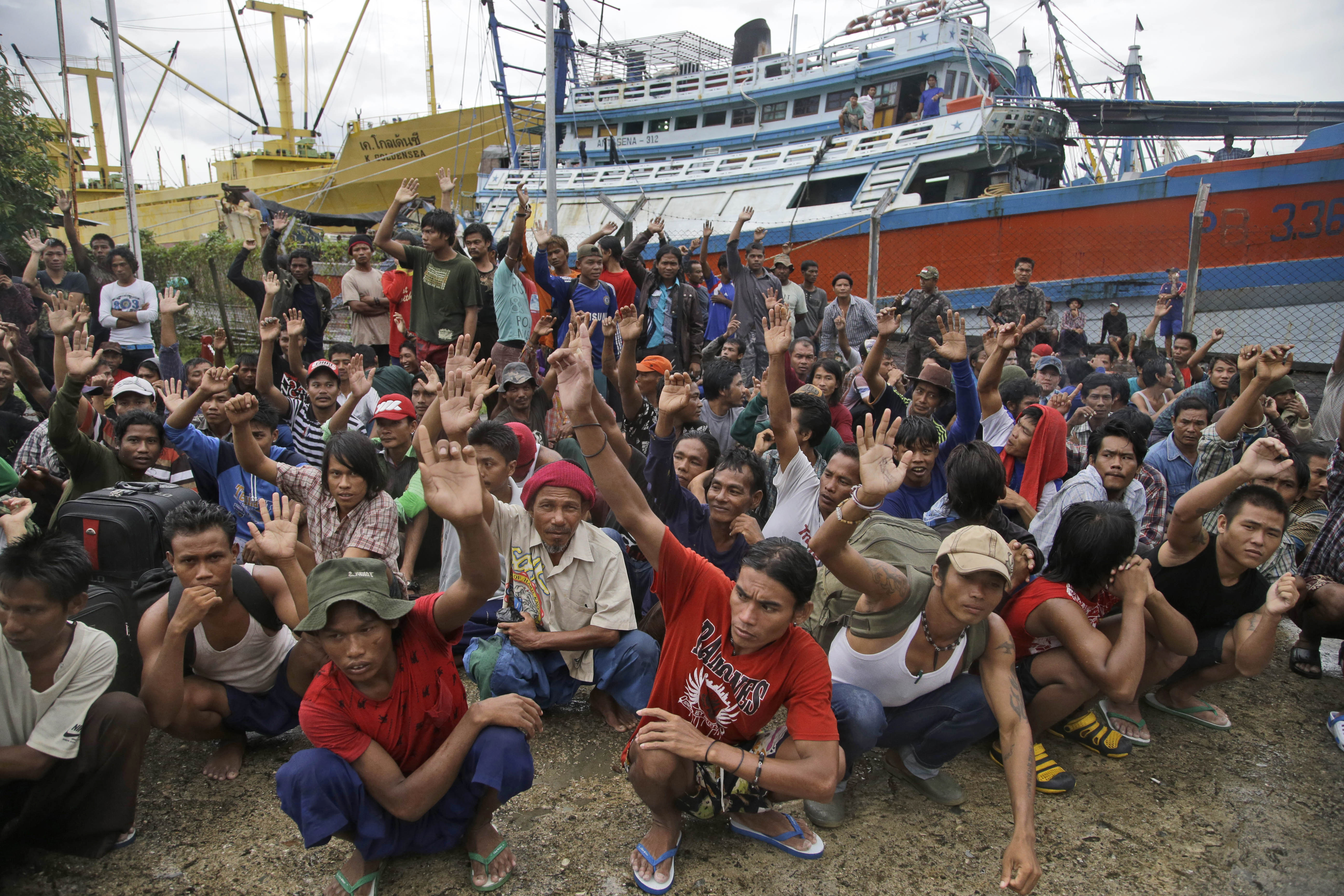Journalists at The Associated Press knew that labor abuses in Thailand’s seafood business were an awful but open secret. They wanted to tell the story of an industry rife with human trafficking, abuse, slavery and murder. And they wanted to make the world pay attention.
The best way to do that was to find those captives and follow the fish they caught on its journey to American tables, said Martha Mendoza, a national reporter at the AP and a Pulitzer Prize winner.
“You know you’re going after the Holy Grail, right?” one source told them.
And they didn’t stop.
Last March, the AP published “Slaves may have caught the fish you bought,” by Mendoza, Robin McDowell and Margie Mason. They followed up with the story of hundreds of slaves rescued after their investigation, how fish caught in Thailand ends up in the U.S., how men separated from their families reunited with them again, more rescues, more admissions from international companies and calls for a U.S. boycott of slave-peeled shrimp.
The series has won a lot of awards, too.
As part of Poynter’s ongoing series on social justice journalism leading up to the centennial edition of the Pulitzer Prizes, we’re speaking with journalists about modern work that exposes injustices. Via email, Mendoza spoke with Poynter about reporting the AP’s fishing industry stories, the work that went into helping to save their sources and the decades of journalism from her team that led up to the series.
How did this series first start for you and your team?
It took a year of digging before we found ourselves on a wooden ferry heading to Indonesia’s remote island village of Benjina, unreachable part of the year because of stormy seas. There were no roads and little electricity. The only way to get a message to the outside world was to climb a hill and pray for a tiny, flickering phone signal.
There was one business, though — a large fishing company. Six Thai trawlers were docked at port when we arrived, with more than 80 others still at sea. After a few days, we were able to talk to dozens of fisherman, most from Myanmar. The level of desperation was staggering. Some were locked in a cage because they had asked to go home. A jungle-covered company graveyard held the bodies of more than 60 fishermen, most buried under fake names. At night, men would run after us on windy, dusty paths, jamming pieces of paper into our hands with the names and addresses of family back home. “Please,” they begged. “Tell them we are alive.”
I’m guessing there was a point in your reporting, maybe when you actually saw people locked in cages, that you knew this story was going to be big. Can you tell us about it?
Robin McDowell was enraged by what she was seeing and hearing on Benjina. She climbed a hill behind the fishing company, the only place where the signal was strong enough to send a phone text message to Margie Mason in Jakarta: “You aren’t going to believe this!”
We didn’t spend much time thinking about how big the story was going to be. We were really focused on the responsibility we now had for these men and the need to get a story out that would have some real impact. That meant we needed to prove where the fish ultimately ended up, tell the story with integrity and detailed accuracy, and protect the men from further exploitation or harm as victims of human trafficking. It was a very intense time. Now and then we wondered if anyone else would care, but we were pretty mission-driven. We are gratified and humbled by the response so far, but we know we have a great deal more to go.
This series was built on investigative reporting, but a lot of other journalism went into it. Can you tell us about the work and the rest of the team involved?
For a year, most every morning and evening in cross-globe, static-laced calls, we strategized with our editor Mary Rajkumar, briefed each other on latest developments, pondered impossible next steps, urged each other to do more, negotiated sentence structure, said tired good mornings and good nights and laughed at the inscrutabilities of life, humanity and the power of finding and reporting the truth.
We are a four-woman team of AP journalists who care about each other and our stories: Robin McDowell spent two decades covering Asia. Her reports from Cambodia and Myanmar highlighted the difficulties young democracies face after emerging from military rule, civil strife and horrific rights abuses. And in Indonesia, where men were trapped for years, sometimes decades, Robin had overseen a busy bureau as it responded to everything from earthquakes and tsunamis to terrorist attacks.
Margie Mason, an AP reporter based in Asia for more than a decade, specializes in medical writing, including coverage of SARS and bird flu. Margie’s stories bring focus and attention to the grinding poverty and human rights abuses throughout the region. Since joining the AP two years ago, Esther Htusan has relentlessly pursued stories about human rights abuses in Myanmar following a half-century of dictatorship. Her interest in covering Rohingya Muslims was almost unheard of in a country where much of the population — including local journalists — looked upon members of the long-persecuted minority with disdain.
You and your team took the step, which has been lauded and awarded, to make sure the people you were quoting were safe and freed from slavery. Tell us about that decision. Have you faced anything like this before?
We faced an ethical dilemma: Publish or protect? Feeling they had nothing left to lose, enslaved fishermen risked their lives to tell their stories. We knew they could be harmed, or worse, if their names and images were published. Blurring their images was never an option; neither AP’s journalistic standards, nor our team, would allow this. Concealing their identity was a possibility, but that would strip the story of its power. Instead, with the support of AP management, we sought help from the International Organization for Migration, which worked with Indonesia’s Marine Police to make sure all eight men featured in photos and video were off the island before the story ran — a difficult task given the bad weather, the island’s remote location and the distrust of the men (some refused to leave until we called to assure them it was safe).
Every complex story brings new journalist quandaries, but arranging a rescue? That was a first.
What else have you seen as a result of the series?
More than a dozen alleged traffickers arrested (eight convicted and sentenced to date); millions of dollars worth of seafood and vessels seized; a federal legal loophole was closed earlier this year when President Obama signed a law that includes a provision barring imports of slave-produced goods. Thai Union, one of the world’s biggest seafood exporters, says it has hired 1,200 workers from outsourced shrimp processing sheds into safer, more closely regulated in-house jobs with decent pay.
Have you or your team stayed in touch with the people you profiled who returned to their homes after years in captivity? How are they adjusting?
There have been beautiful reunions, but many have since been saddled by shame after returning home empty handed after years abroad. Some have vowed to never leave their families again; a few, unable to escape the cycle of poverty and desperation, have already returned to Thailand and are working in questionable circumstances. Many had hoped companies responsible would be forced by the international community or courts to compensate the fishermen for years of forced labor. That has not happened. Some bore witness in criminal proceedings against arrested traffickers. A handful have been aided by humanitarian NGOs. Many of these men are still in regular contact with us.
What advice do you have for journalists who cover or want to cover human rights? Where should they start?
Day in, day out, journalists reading Poynter blogs are already covering human rights, whether it’s in schools, courts, legislatures or communities. We just encourage everyone to keep it up! Some human rights abuses are open secrets, and society tends to just accept them. Don’t. As journalists we can take an open secret and make people see it for what it really is. It’s tough and can be emotionally exhausting, but it’s so important not to give up even when you’re told it’s impossible. This project is proof that journalism can make a difference and truly give voice to those who are invisible.
What other human rights and social justice stories do you think deserve our attention right now?
Challenge injustice everywhere and all the time. Here are just a few examples: human trafficking, migrant abuses, educational inequalities, criminal justice abuses, racism, sexism, environmental destruction, business and political corruption, religious and cultural attacks, health care disparities. We’re just getting started here…

FILE – In this Friday, April 3, 2015 file photo, Burmese fishermen raise their hands as they are asked who among them wants to go home at the compound of Pusaka Benjina Resources fishing company in Benjina, Aru Islands, Indonesia. On Thursday, March 10, 2016, five Thai fishing boat captains and three Indonesians were sentenced to three years in jail for human trafficking in connection with slavery in the seafood industry. The suspects were arrested in the remote island village of Benjina in May 2015 after the abuse was revealed by The Associated Press in a report two months earlier. (AP Photo/Dita Alangkara)







